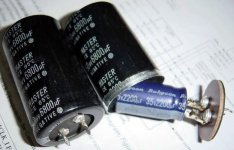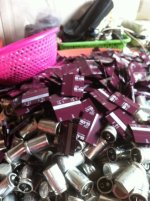Hi! For a few weeks ago I bought some big-as$ Nippons caps at Ebay, 22000uF, 63v.
I paid roughly 6$ per cap, so I guessed these where genuine Japanese caps.
Today I was going to find the datasheet for these puppies. I searched at Nippon Chemi-con's webpage, but I could only find 22000uF 35v caps in that package size (35mm diameter and 50mm height)
The capacitors looks really genuine, with the Nippon logo and everything. The printing on my caps are crystal clear and in sync with the negative side. Still Nippon Chemi-con does not have any 22000uF capacitor at their website rated at 63v that have this package size.
Is there possible to measure a capacitor's maximum voltage limit?
You can find all these capacitors at ebay if you search for "22000uF 63v", but Here is the Ebay link where I bought mine.
So, why can't I find any datasheet on the internet? How can I find out if these are fake (and doesn't match the specs)?

Screenshot from Nippon Chemi-con's website, filtered "22000uF", "63v"
I paid roughly 6$ per cap, so I guessed these where genuine Japanese caps.
Today I was going to find the datasheet for these puppies. I searched at Nippon Chemi-con's webpage, but I could only find 22000uF 35v caps in that package size (35mm diameter and 50mm height)
The capacitors looks really genuine, with the Nippon logo and everything. The printing on my caps are crystal clear and in sync with the negative side. Still Nippon Chemi-con does not have any 22000uF capacitor at their website rated at 63v that have this package size.
Is there possible to measure a capacitor's maximum voltage limit?
You can find all these capacitors at ebay if you search for "22000uF 63v", but Here is the Ebay link where I bought mine.
So, why can't I find any datasheet on the internet? How can I find out if these are fake (and doesn't match the specs)?

Screenshot from Nippon Chemi-con's website, filtered "22000uF", "63v"
Last edited:
The quickest way to check if they're fake is run them up gently to full working voltage on a bench variable supply while monitoring the leakage current. It should be comfortably below 10mA after a minute or two. Higher than this, they'll be fakes.
I have some (a whole box full) of 15000uF 25V Rubycons which given their low price ($0.30) are probably fakes, but they pass this test.
I have some (a whole box full) of 15000uF 25V Rubycons which given their low price ($0.30) are probably fakes, but they pass this test.
I'm guessing fake. Based on the printing (something is off and a bit sloppy about it), the fact it isn't in the datasheet for KMH and the fact that its on ebay.
The quickest way to check if they're fake is run them up gently to full working voltage on a bench variable supply while monitoring the leakage current. It should be comfortably below 10mA after a minute or two. Higher than this, they'll be fakes.
I have some (a whole box full) of 15000uF 25V Rubycons which given their low price ($0.30) are probably fakes, but they pass this test.
Don't forget some eye protection !
an example of fake cap taken from this site
VIP???PC @ Wiki - "???"??
monitoring leakage is a good idea.
or you can ask Nippon Chemi-con
http://www.chemi-con.co.jp/e/toiawase/inquiries.html
VIP???PC @ Wiki - "???"??
monitoring leakage is a good idea.
or you can ask Nippon Chemi-con
http://www.chemi-con.co.jp/e/toiawase/inquiries.html
Attachments
Last edited:
an example of fake cap taken from this site
VIP???PC @ Wiki - "???"??
monitoring leakage is a good idea.
or you can ask Nippon Chemi-con
Nippon Chemi-Con Corporation / For Overseas Residents
Im not going to address the veracity of the image. I have often heard that image is from an example on how to retrofit a cap into an older larger one for restoration purposes.
You can also ask NCC's sister company United Chemi-con .
Hi guys! I measured my capacitors at my schools expensive LCR meter today, and none of the six caps measured more than 16000uF (they measured between 13000uF and 16000uF), and I also tried to vary the frequency.
I'm going to contact the seller, and tell him all about this. So my advice is that if you're going to buy expensive capacitors, make sure there exist some documentation or a datasheet!
I'm going to contact the seller, and tell him all about this. So my advice is that if you're going to buy expensive capacitors, make sure there exist some documentation or a datasheet!
Problem is also with website UCC and NCC, they do not show all they produce.
Or Digikey is willing to sell you fake UCC's too, they can order 2 different heights UCC 22000uF 63V for you in 35mm, non stock. Mouser offers to order new SMH too in 35mm 63V 22000uF. I bet they do exist, or will soon KMH they do not offer in this diameter.
KMH they do not offer in this diameter.
So UCC/NCC website isn't proof of anything by itself I fear, although you seem to have got the correct idea from it by accident.
Or Digikey is willing to sell you fake UCC's too, they can order 2 different heights UCC 22000uF 63V for you in 35mm, non stock. Mouser offers to order new SMH too in 35mm 63V 22000uF. I bet they do exist, or will soon
So UCC/NCC website isn't proof of anything by itself I fear, although you seem to have got the correct idea from it by accident.
These are actually quite easy to spot.. look at the print. There must be millions of fake caps on ebay .. Im surprised that they still allow it. There are more fakes then legit ... Guess they dont care as long as they are making money themselves.
Both size and print are strange, to say the least. They should be atleast twice as big.
Strange how (swag) 90% of all the caps sold by chinese users, have the same dimensions, no matter what brand or specs clamied.
Try rubbing alcohol (rødsprit er fint, heh) on the label .. se if the print comes of.
Both size and print are strange, to say the least. They should be atleast twice as big.
Strange how (swag) 90% of all the caps sold by chinese users, have the same dimensions, no matter what brand or specs clamied.
Try rubbing alcohol (rødsprit er fint, heh) on the label .. se if the print comes of.
I have not read all the replies, so I may be repeating what is already posted.
1.) reform slowly to specified max working voltage
2.) test leakage current after reforming.
3.) test vdrop before and after attaching a 100k load resistor to a fully charged capacitor.
Do not hold the test probes on the terminals during the time waiting for the Vdrop to occur during test 3.
The RC for a 22mF with a 100k load is ~2200seconds, about 37minutes.
Charge to 63Vdc.
Wait a minute to let the leakage settle.
Attach the 100k with croc clips.
Probe the voltage just long enough to get a stable reading, disconnect at the same time you start the timer/timing.
Wait exactly 10minutes. Probe again to measure the new voltage. Check what discharge you would expect in 10 minutes from the 37minute RC.
Wait until 20minutes from first V reading, Probe again and measure the new voltage. Check what discharge you would expect in 20 minutes from the 37minute RC.
Wait until 30minutes from first V reading, Probe again and measure the new voltage. Check what discharge you would expect in 30 minutes from the 37minute RC.
Wait until 40minutes from first V reading, Probe again and measure the new voltage. Check what discharge you would expect in 40 minutes from the 37minute RC.
Each probing to take a measurement discharge the capacitor a little faster, so make it quick.
Once you have a final estimate for the C then you can repeat the recharge and test to the final RC time without any intermediate measurments to see how close to the 62%/63% discharge one would expect.
To speed this up you could substitute a 10k loading resistor to get down to an RC of 220seconds.
BTW, each recharging will probably reduce the leakage very slightly from the first reform.
If one is good then they are all good.
But reform and check leakage on all of them. Excessive leakage after reforming indicates a fault, or too old, or previously used and plates depleted.
1.) reform slowly to specified max working voltage
2.) test leakage current after reforming.
3.) test vdrop before and after attaching a 100k load resistor to a fully charged capacitor.
Do not hold the test probes on the terminals during the time waiting for the Vdrop to occur during test 3.
The RC for a 22mF with a 100k load is ~2200seconds, about 37minutes.
Charge to 63Vdc.
Wait a minute to let the leakage settle.
Attach the 100k with croc clips.
Probe the voltage just long enough to get a stable reading, disconnect at the same time you start the timer/timing.
Wait exactly 10minutes. Probe again to measure the new voltage. Check what discharge you would expect in 10 minutes from the 37minute RC.
Wait until 20minutes from first V reading, Probe again and measure the new voltage. Check what discharge you would expect in 20 minutes from the 37minute RC.
Wait until 30minutes from first V reading, Probe again and measure the new voltage. Check what discharge you would expect in 30 minutes from the 37minute RC.
Wait until 40minutes from first V reading, Probe again and measure the new voltage. Check what discharge you would expect in 40 minutes from the 37minute RC.
Each probing to take a measurement discharge the capacitor a little faster, so make it quick.
Once you have a final estimate for the C then you can repeat the recharge and test to the final RC time without any intermediate measurments to see how close to the 62%/63% discharge one would expect.
To speed this up you could substitute a 10k loading resistor to get down to an RC of 220seconds.
BTW, each recharging will probably reduce the leakage very slightly from the first reform.
If one is good then they are all good.
But reform and check leakage on all of them. Excessive leakage after reforming indicates a fault, or too old, or previously used and plates depleted.
Polida something or other is one of the bad capacitor fakers on ebay.
On the other hand, an excellent Taiwanese supplier is "electricslee". I have been buying from him for years, and before my first order, I requested his documentation as an authorized distributor for Wima, which he provided, and I cross-checked.
He has Vishay, Nippon, and many others.
I have bought from him many times, and have never been disappointed. No, he's not the cheapest, but he's reliable and consistent.
On the other hand, an excellent Taiwanese supplier is "electricslee". I have been buying from him for years, and before my first order, I requested his documentation as an authorized distributor for Wima, which he provided, and I cross-checked.
He has Vishay, Nippon, and many others.
I have bought from him many times, and have never been disappointed. No, he's not the cheapest, but he's reliable and consistent.
- Status
- This old topic is closed. If you want to reopen this topic, contact a moderator using the "Report Post" button.
- Home
- Design & Build
- Parts
- Fake Nippon Chemi-con caps?

